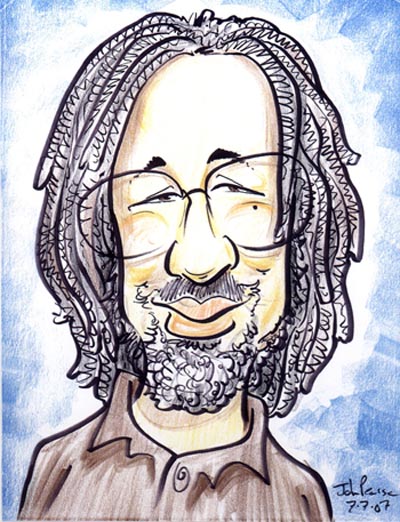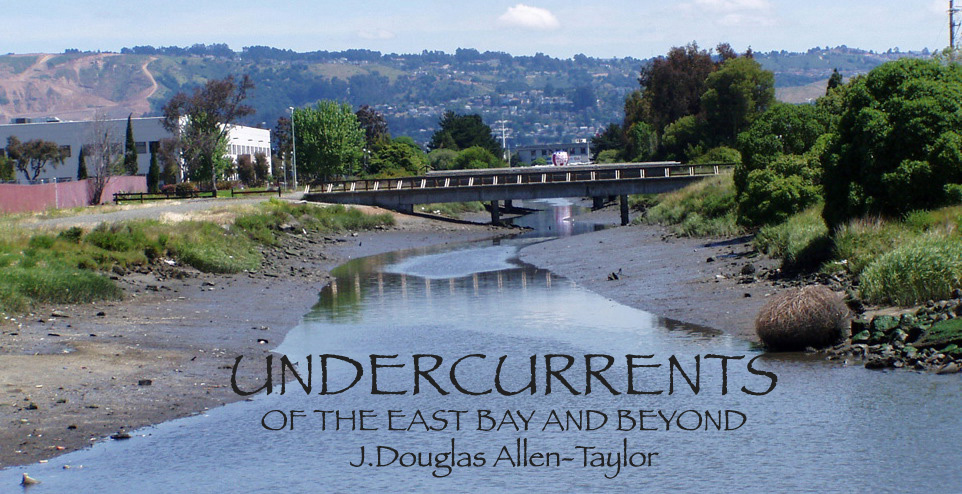|
|
THE IMPORTANCE OF BRT
November 20 , 2008
One of the most important single development decisions that inner East Bay residents can make in the next several years surrounds AC Transit agency’s proposed Bus Rapid Transit system (BRT). Unfortunately, to date only a handful of officials and residents have been paying close attention to the project. That’s got to change.
AC Transit is proposing running a high-speed bus line from downtown San Leandro through downtown Oakland to downtown Berkeley using the E. 14th Street/International Boulevard/Telegraph Avenue route currently operating the 1 and 1R lines. The best-known—and most controversial—aspect of the BRT proposal is to dedicate bus-only lanes in the center of the streets along the route, but other portions of the proposal include modified coordination with traffic lights to eliminate as many red light stops as possible for the BRT buses, as well as the setting up of awning-style partially-covered bus stops where tickets can be purchased, allowing “proof of payment” boarding on the front and back of the buses to speed up service by eliminating front-door delays while passengers pay at the fare box,
In many ways, BRT is set up to function as a sort of light-rail-lite, with buses substituting for trains and dedicated, bus-only center lanes functioning light light-rail lines without the major expense of putting in rails.
I fell in love with light-rail some years ago during the time I was working in San Jose and used it frequently to get from the downtown area to the city’s northside civic center, and several times expressed the hope in writing that such a system could be imported to the inner East Bay as a component of our public transportation system. However, I confess that I was initially skeptical when I first saw AC Transit’s BRT proposal.
There were several reasons for this skepticism.
The first is that however AC Transit touts the light-rail like qualities of BRT, including speed and proof-of-payment boarding, buses can never duplicate the ease-of-riding that you experience on rail. That was exacerbated by the announced intention by AC Transit to use the 60 foot articulated Van Hools as the backbone of the BRT fleet. Because I’ve never ridden any other articulated bus (the two-portion buses with the accordion-type connection in the middle) other than Van Hools, I cannot say for sure that the problem is with the Van Hool artix in particular or articulated buses in general. In this case, however, it doesn’t matter. In my opinion, the Van Hool articulated buses give the worst ride of any bus I’ve ever ridden, the exact opposite of what I was looking for in light-rail, and something I feel would turn potential new riders away from the BRT system rather than attract them, as would be needed to make it successful.
A second concern I have with AC Transit’s proposed BRT is that in some key ways, it duplicates the area’s existing high-speed public transit line: BART. AC Transit proposes BRT to run between either the downtown San Leandro or Bayfair BART stations and the downtown Berkeley BART station. Although BRT would directly serve important major transportation corridors that BART does not—all of E. 14th in San Leandro, most of International Boulevard in Oakland, and all of the Telegraph Avenue route—its three downtown service points—San Leandro, Oakland, and Berkeley—are all in direct competition with BART.
God knows that BART is an imperfect system, designed primarily for inter-city travel (between, say, Concord and San Francisco) than inner-city travel within Berkeley or Oakland. However, BART is already in place and is neither going away or going to add any inner-city routes, and so, if we are to look at our transportation needs as a whole rather than AC Transit’s particular needs or wants, a more prudent way to spend any available transportation dollars would be to find ways for AC Transit buses to complement—rather than compete with—the BART line. That would mean buttressing up the AC Transit feeder lines between BART and major inner East Bay street corridors, something which has become more and more neglected as AC Transit has run into financial difficulties (as an example, while BART runs until midnight, the AC Transit line that connects the BART Coliseum Station and my neighborhood—near International and Allen Temple Church—stops running at 7 p.m.; there is no way to get from BART to my house after 7 unless you have driven and parked in the parking lot, can call someone to pick you up, catch a $5 cab, or risk walking in the dark along some of Oakland’s most dangerous streets).
Another pressing public transportation need not addressed by AC Transit’s proposed BRT is connecting neighborhoods with Oakland and Berkeley’s successful neighborhood commercial centers, such as the Laurel, Grand Avenue-Lakeshore, College Avenue, Piedmont Avenue, 4th Street, and Solano Avenue. Many of these neighborhood commercial centers have reached capacity not because of lack of demand, but because they simply have noplace in which to accommodate more traffic and parking. A major AC Transit expansion that begins in cooperation with local governments to connect more shoppers with these neighborhood commercial centers would generate additional retail tax revenue for the cities—particularly Oakland, which is in desperate need of such—which could in turn be passed on in part to AC Transit to buck up its own dwindling financial resources.
Another concern I have with BRT—or any new AC Transit initiative at this time, for that matter—is AC Transit’s current cavalier manner of doing business, which I’ve outlined in detail in a number of columns and Berkeley Daily Planet news articles. I am not ready to declare that this is the result of malfeasance, as some of my friends and newspaper colleagues have done. But as a working journalist who has covered councils, boards, and commissions throughout the Bay Area for several years, it is my feeling that the current AC Transit administration—aided by the board—operates far too loosely with facts and finances for my taste, or my trust, with General Manager Rick Fernandez far too often pulling statistics or strategic reasoning off the top of his head when questioned at board meetings rather than putting these down on paper in staff reports as they should be, and too often the board going along and not exercising its proper oversight responsibility. Again, I’m not ready to declare this malfeasance, only a sort of mom-and-pop culture of fiscal and administrative looseness that has grown up out years of being out of major scrutiny by either the press or the general public.
All that being said, there are major reasons why I do not think the inner East Bay public or the three city councils that represent citizens along the proposed BRT line should outright reject BRT.
When it was first formed by the California legislature in 1957, BART consisted of representatives of five counties (Alameda, Contra Costa, San Francisco, Marin, and San Mateo) and was intended to create a high-speed electric train loop that circled the rim of the bay. The difference between that proposed system and what we have today would have been the inclusion of a connection between San Rafael and San Francisco and San Rafael and Richmond, paralleling the routes of the Golden Gate and San Rafael-Richmond bridges, as well as a southern loop connecting San Mateo and Hayward. No-one in 1957 could envision the Silicon Valley boom out of the orchards and farmland of the Santa Clara Valley, but even a decade later, when BART was actually built, government, development, and transportation visionaries could have been able to see the value of extending the original proposed southwestern terminus down to San Jose, and then back up the eastern bayshore through Hayward and north.
Had the BART lines been built in that manner in the 1960’s, when the price of land right-of-way purchase was exponentially cheaper than now and government funds were more easily had, and if the lines and stations had been configured to accommodate more trains at a time, we would have mitigated some of the Bay Area’s most pressing traffic difficulties of the last 30 years, particularly those connecting the Bay Area with Silicon Valley. Extending BART lines north and south now—and across the bay at its northern point—makes eminent transportation and public policy sense today and eventually, we will almost certainly do it. But the tax dollar and political costs are going to be huge, and far more difficult than if we had done so in the 1960’s.
And that is why we cannot take AC Transit’s BRT off the table, despite its many flaws. At some point, we are going to have to bring back light rail travel to the inner East Bay. We must do so in order to accommodate travel in an increasingly-dense Bay Area in the 22nd century and beyond. Whether such a system is run by AC Transit, by another existing agency, or some new creation or transportation hybrid is beside the current point. BRT’s most controversial aspect—its dedicated bus lanes—will be a major component of that light rail system. If we do not dedicate bus lanes today—to eventually be turned into light rail tracks at some future point—we will have to do it tomorrow, with escalated political problems, economic dislocations and discomfort, and tax costs that will dwarf anything the current BRT proposal could possibly imagine.
What is most important, the federal money is available now for BRT. At some future point, when we have come to recognize the need, that money may no longer be there.
This is not meant to overlook or dismiss my concerns—or the concerns of others—about the BRT proposal in its current form. For one thing, I do not think BRT needs to be wedded to the Telegraph Avenue portion of the line. A major case could be made that for many reasons—including a thoroughfare that is ready-made for dedicated bus lanes and a direct connection to the booming Emeryville retail centers—the northern spur of BRT might more properly run down San Pablo Avenue rather than Telegraph, thence up University to downtown Berkeley. In fact, the kind of residential-retail infill that BRT is supposed to enhance makes far more sense along San Pablo than it does along Telegraph.
But that is only one suggestion.
My major point is that while the BRT proposal has major flaws—and while the government-corporate culture at AC Transit itself has problems which desperately need correcting—BRT needs the benefit of a longer view, and a wider discussion base, than it has currently been getting. This is an argument for a greater public and government involvement in the BRT process in order to reform the proposal and make it work. This won’t be the last chance for inner-city public transportation upgrade in the inner East Bay, but if we miss this chance, we or are children will be kicking ourselves and themselves in years to come.
|

